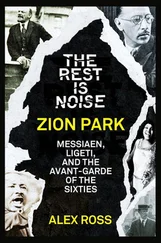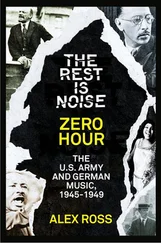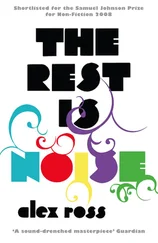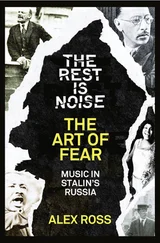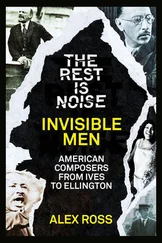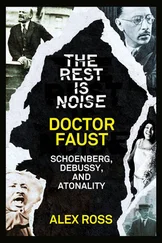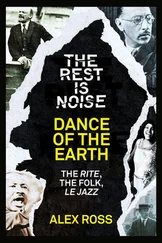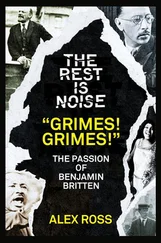A few other New York–based composers were thinking along similar lines, and they gravitated into Cage’s orbit. The most important of these was Morton Feldman, a New York native who had steeped himself in Bartók, Varèse, the Second Viennese School, and Abstract Expressionist painting. It was Feldman who set loose the imp of chance; one day at Cage’s apartment he offered up for inspection a draft of a piece titled Projection 1 , whose score consisted not of notes on staves but of a grid of boxes, each box lasting a certain period of time and indicating a high, middle, or low range. This novel practice came to be known as graphic notation: the composer was no longer telling performers exactly which notes to play at any given time.
A laboratory atmosphere developed in Cage’s apartment. Other frequent visitors were the teenage experimental prodigy Christian Wolff, whose early works drew on severely limited gamuts of three or four pitches; Earle Brown, whose open-form pieces imported some of the energy of bebop; and the pianist David Tudor, whose realizations of his friends’ graphic and chance scores were compositions in themselves.
Cage launched his revolution at three historic concerts in the spring and summer of 1952. First came Water Music , at the New School for Social Research, in May. David Tudor not only played the prepared piano but shuffled cards, poured water from one receptacle to another, blew a duck whistle, and changed stations on a radio. Each action was plotted on a time continuum. Then came Black Mountain Piece , at Black Mountain College, the first true “happening.” The boundary between artist and audience disappeared as participants stepped out of the crowd to perform musical or extramusical actions. Martin Duberman, in his history of the college, valiantly tried to determine what happened at the happening, but no two accounts agreed. Cage lectured on Zen Buddhism, perhaps standing on a ladder. Robert Rauschenberg exhibited artworks and/or played Edith Piaf records at double speed. Merce Cunningham danced. David Tudor played prepared piano. Movies of some kind were shown, boys or girls served coffee, a dog may or may not have barked. Black Mountain had always been a haven for adventurous spirits, but some of the faculty felt that Cage had gone too far. Stefan Wolpe, who had gone through his own Dada phase in 1920s Berlin, walked out in protest.
The final breakthrough was the premiere of 4 9 33 0 , the so-called silent piece, on August 29, in the upstate New York town of Woodstock. Cage later said that he had been inspired to write 4 9 33 0 after seeing a group of all-white Rauschenberg canvases at Black Mountain the previous year. “Music is lagging,” he thought to himself, on encountering Rauschenberg’s work. In fact, he had already experimented with spells of silence in Music of Changes , and, back in 1948, he had talked about writing a four-and-a-half-minute soundless piece titled Silent Prayer . Rauschenberg simply emboldened him to do the unthinkable.
The original score was written out on conventional music paper, tempo = 60, in three movements. David Tudor walked onstage, sat down at the piano, opened the piano lid, and did nothing, except to close the lid and open it again at the beginning of each subsequent movement. The music was the sound of the surrounding space. It was at once a head-spinning philosophical statement and a Zen-like ritual of contemplation. It was a piece that anyone could have written, as skeptics never failed to point out, but, as Cage seldom failed to respond, no one else did.
The bourgeois piano having been silenced, the age of the machines could begin. On his European trip of 1949, Cage encountered several pioneering technicians of electronic music, who had set in motion the most sweeping of all postwar campaigns against the musical past.
The previous year, Pierre Schaeffer, an engineer at the French national radio network, had devised five electronic Études of Noises , one movement of which consisted of the huffing, chugging, and whistling of six locomotives that he had recorded in the Batignolles train station. Schaeffer worked initially with phonograph discs, but he soon realized that magnetic-tape recording, which German engineers had perfected during the war, allowed for the making of sound collages by way of cutting and splicing bits of tape. (His initial research into musical acoustics had actually taken place during the war, with the approval of the occupying German forces.) Schaeffer went on to create, in collaboration with another Messiaen pupil, Pierre Henry, an extended collage work titled Symphony for a Solitary Man . Schaeffer dubbed his work musique concrète and developed his tape fragments with contrapuntal intensity—playing them backward, speeding them up, slowing them down, slicing off the attack, or turning them into loops.
When Cage came to Paris, Boulez, knowing of his long-standing fascination with electronic gizmos, introduced him to Schaeffer. A few years later, in New York, Cage gained access to German-style magnetic-tape recorders, and, at the studio of Louis and Bebe Barron, he laboriously put together the four-minute tape collage Williams Mix , one of a group of pieces that emerged from the collaborative Project for Music for Magnetic Tape. The material came from an enormous heap of tape fragments, which were distributed in six categories: city sounds, country sounds, electronic sounds, manually produced sounds, wind sounds, and “small” sounds. Cage subjected these to I Ching manipulations, producing constant jumps from one sound to another or buzzing, scrambled textures of up to sixteen simultaneous layers. Notwithstanding the emotional detachment of the method, Williams Mix has the air of a world gone berserk, of modernity imploding on itself.
Imaginary Landscape No. 4 (1951), for twelve radios, partakes of the same mad house atmosphere: two players are positioned at each radio, one switching stations according to patterns specified in the score, the other making adjustments to volume. A more pointed satire of media-saturated society could hardly be imagined, although, as ever, the composer’s attitude is studiously deadpan. Some part of Cage longed for pretechnological, even preindustrial life. In his 1950 “Lecture on Nothing,” he quoted a woman from Texas who told him, “We have no music in Texas.” He then said, “The reason they’ve no music in Texas is because they have recordings in Texas. Remove the records from Texas and someone will learn to sing.”
All this was too much for Boulez, who was soon speaking as with-eringly of Cage as he had of so many others. By the seventies he was calling his former friend a “performing monkey” whose methods betrayed “fascist tendencies”—thereby putting Cage next to Strauss, Sibelius, and Stravinsky in the crowded room of composers who had been labeled fascist for one reason or another.
Конец ознакомительного фрагмента.
Текст предоставлен ООО «ЛитРес».
Прочитайте эту книгу целиком, купив полную легальную версию на ЛитРес.
Безопасно оплатить книгу можно банковской картой Visa, MasterCard, Maestro, со счета мобильного телефона, с платежного терминала, в салоне МТС или Связной, через PayPal, WebMoney, Яндекс.Деньги, QIWI Кошелек, бонусными картами или другим удобным Вам способом.

